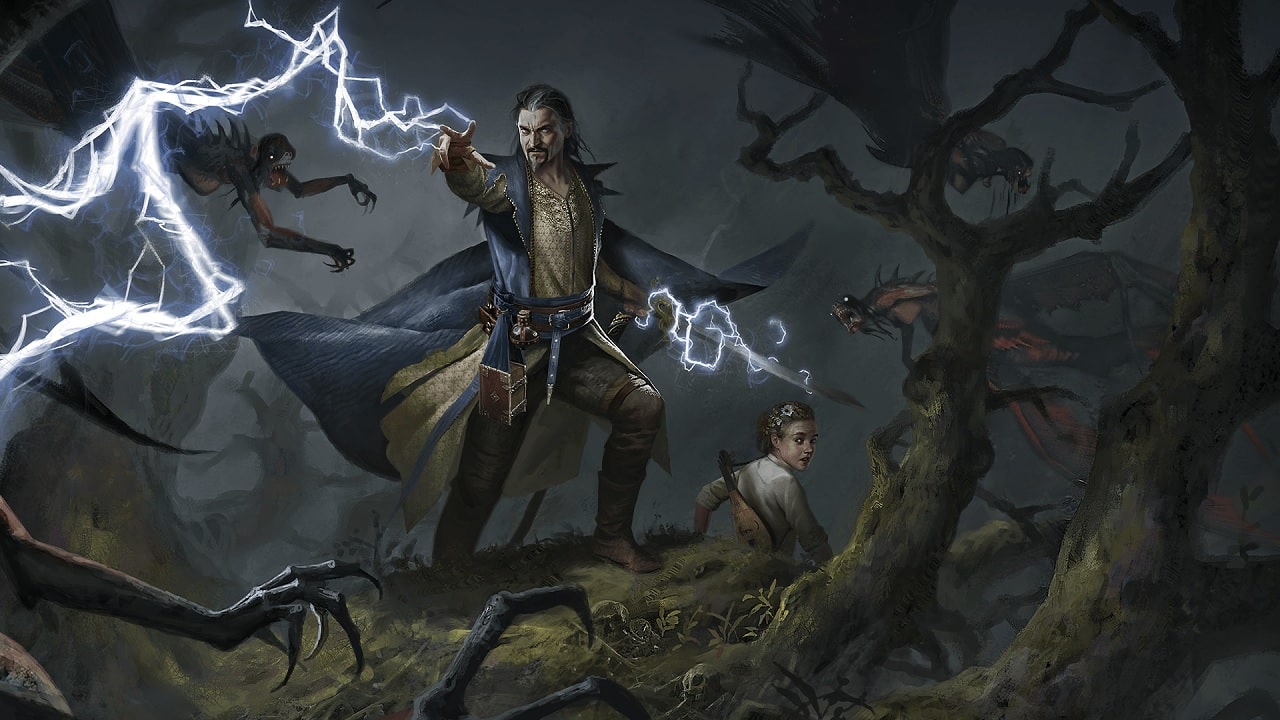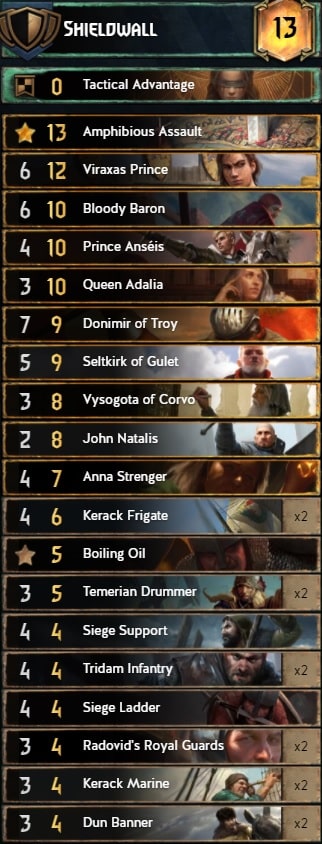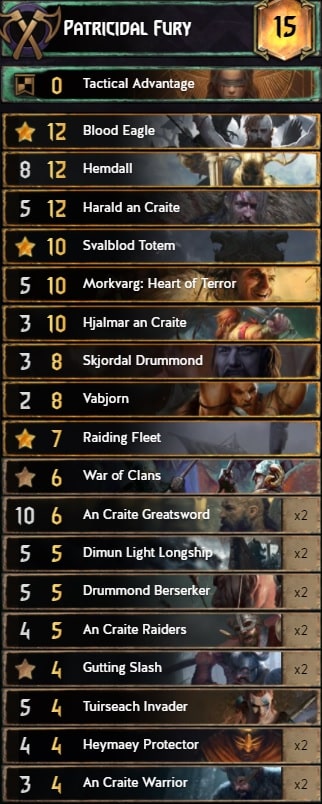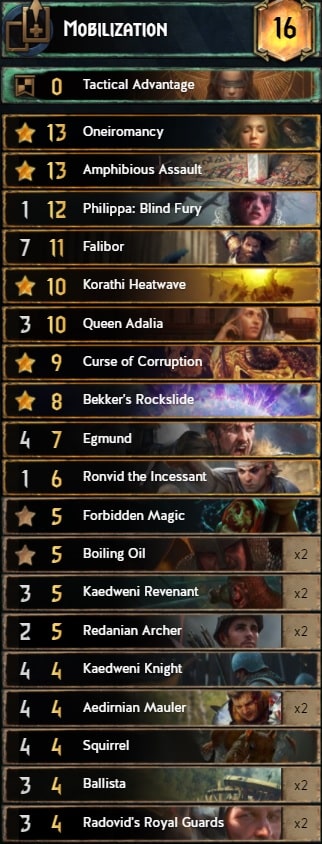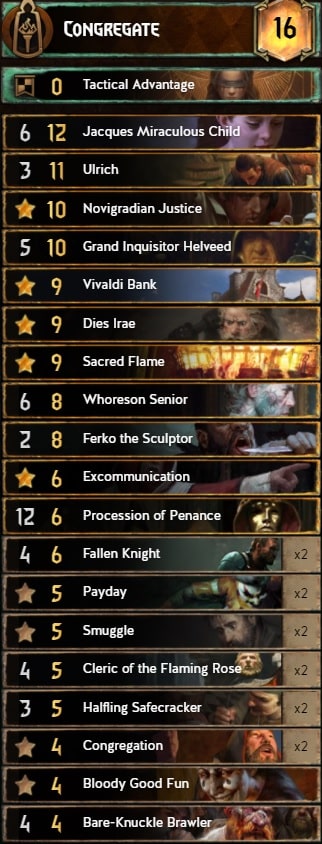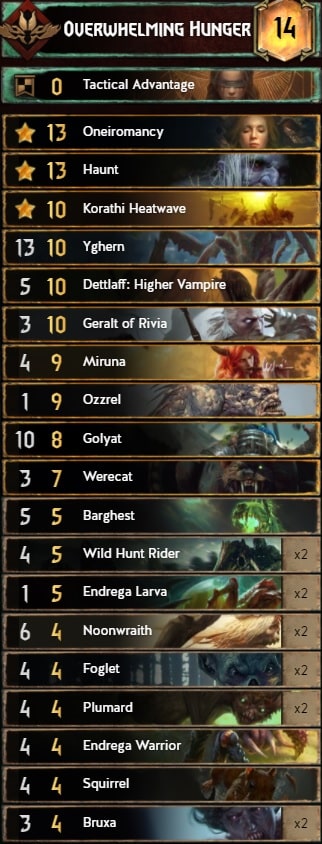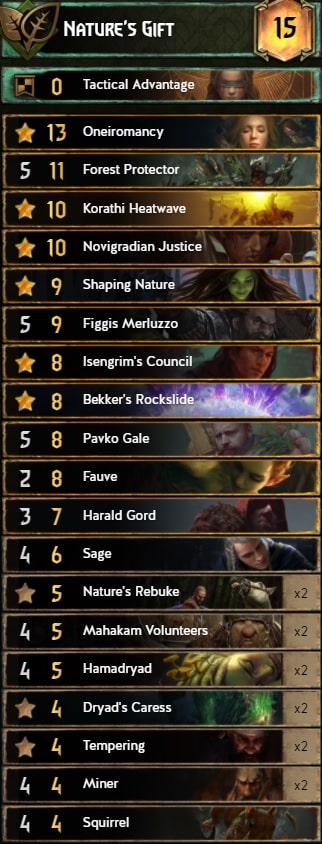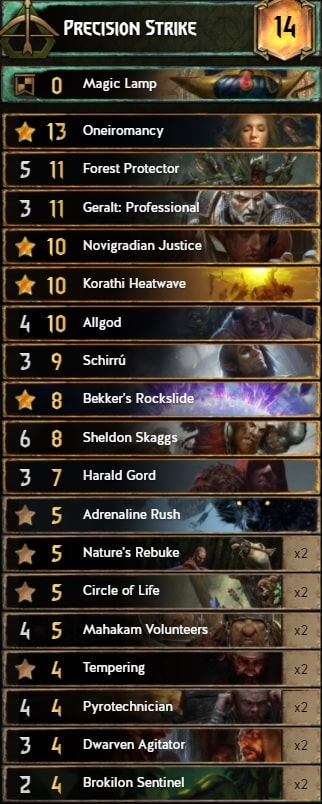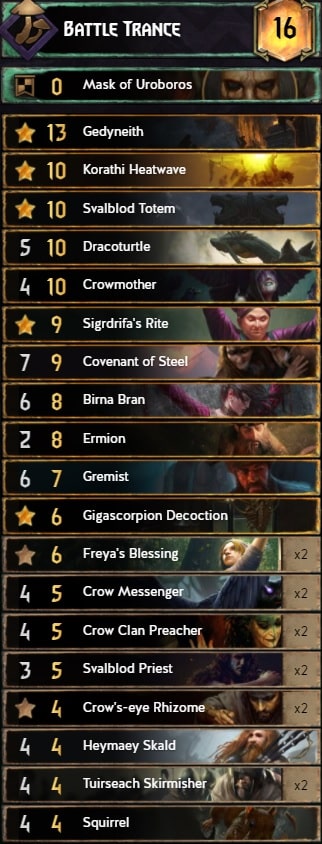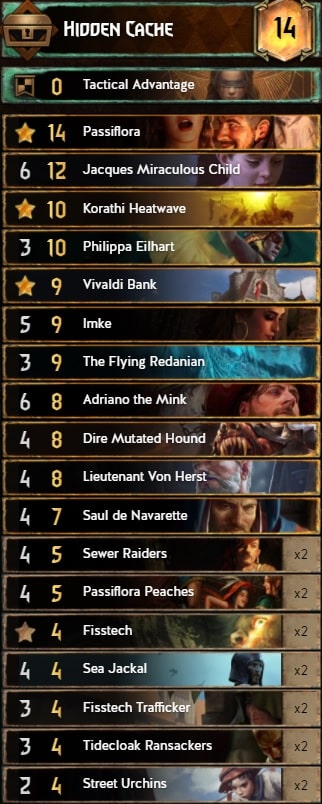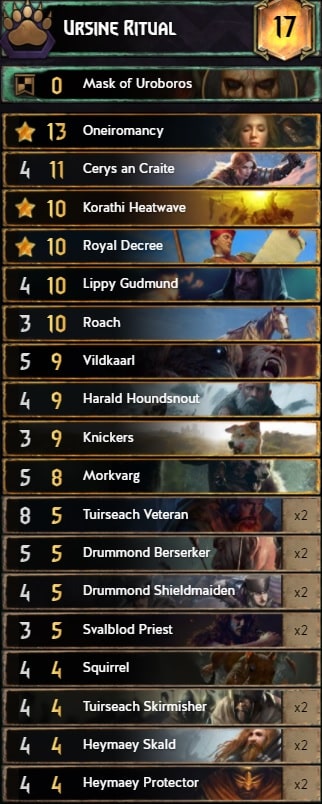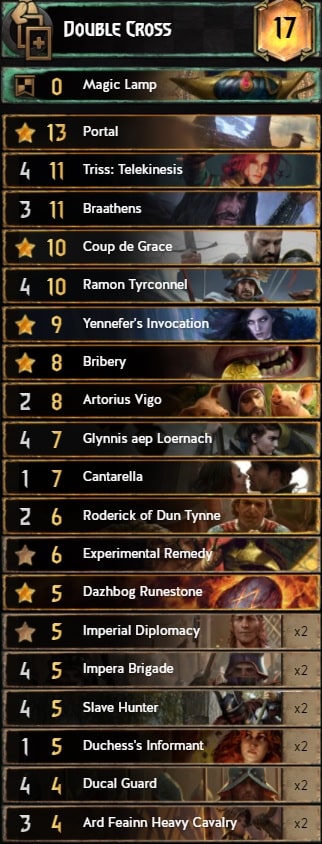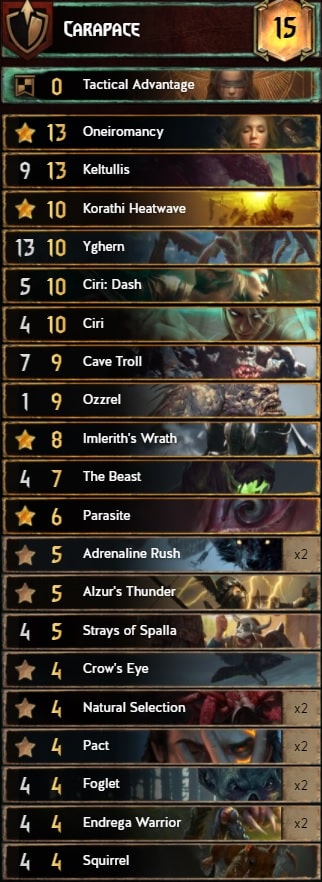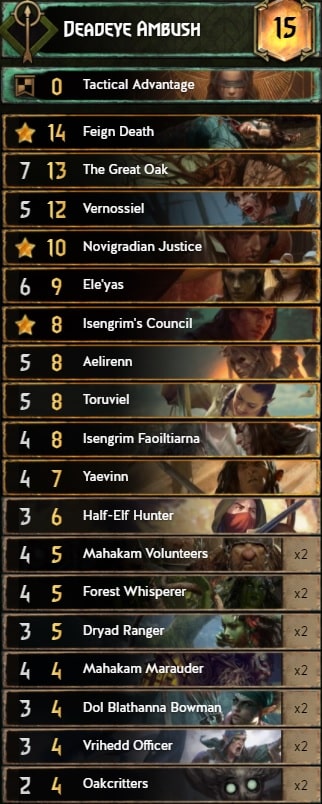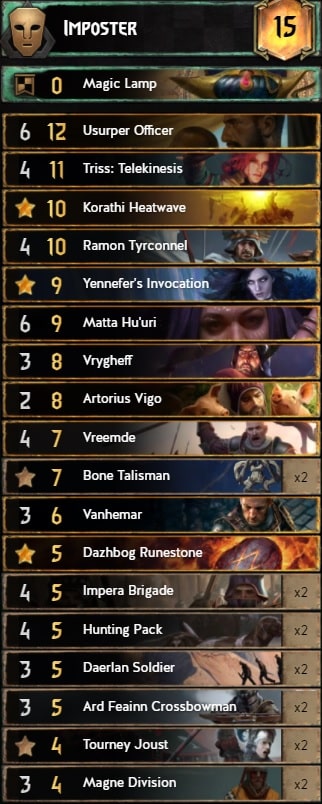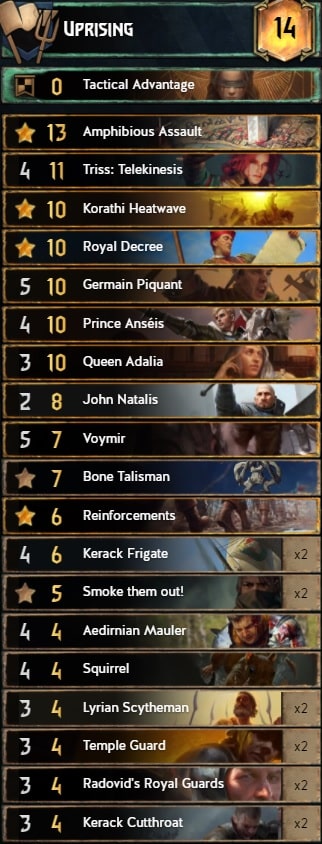Welcome to our 19th meta report! With Rage of the Sea nerfed and the Season 2 of Gwent Masters nearing its conclusion, we’re seeing more variety in pro rank. NR players can choose between Shieldwall with Viraxas and Mobilization Revenants. ST can either utilize Precision Strike to wipe out the opposing units or go for a more proactive approach with Nature’s Gift.
MO are soaring in popularity this month, playing many variations of Overwhelming Hunger. SK Warriors are still playable, however Lippy and Gedyneith both made a comeback. The nerf to Passiflora wasn’t as bad as expected, so SY can opt for Hidden Cache or the Swarm-based Firesworn deck. NG is so flawed that even Masquerade Ball can’t hope to save the day.
We will update the report regularly in order to provide the community with a spot-on representation of the current meta. You can join our Discord if you have any questions.
Graphics: WellMax81
Editing: Wusubi
Writers: BeardyBog, KingChezz93, Minuano, Pajabol, Saber97, SpyroZA, Thekeyer
Consultants: Bantonio, Gravesh, Green-Knight, McP0yle, Qnerr

Despite getting nerfed by three provisions, Shieldwall is still the deck to beat. The fact that SK Warriors (Shieldwall’s great rival) have received a couple of severe nerfs certainly helps. War Elephant has been replaced by Bloody Baron, who does an excellent job at countering the greedy meta. With potent engines and threatening leader targets in Vysogota, Prince Anséis and Seltkirk, Shieldwall preys on proactive decks like Overwhelming Hunger. However, you don’t have a tutor for your expensive units, which can be a problem given how consistent the other meta decks are. -Wusubi
Strengths:
- Very efficient pointslam, engines and flexible control tools
- Amphibious Assault and/or Queen Adalia provide a reliable way to win the first round
Weaknesses:
- Control decks like Revenants can beat Shieldwall with ease
- You don’t have a tutor for your high-end cards, which can lead to some disappointing losses simply due to not drawing Prince Anséis and/or Viraxas Prince
Considerations:
- Falibor, Reynard Odo
With Rage of the Sea losing one of its charges, winning Round 1 and bleeding the opponent without overcommitting becomes more difficult. On top of losing flexibility, Greatsword got nerfed as well. The prevalence of Overwhelming Hunger doesn’t help, as Warriors tended to struggle with this matchup even before receiving multiple nerfs. That being said, you’ll still have a decent amount of removal and a powerful bronze package, allowing you to dictate the pace of the game. -Wusubi
Strengths:
- Very consistent due to Vabjorn, Blood Eagle and Raiding Fleet
- With strong bronzes, reliable control tools and some pointslam options, you can adjust your game plan according to the matchup
Weaknesses:
- Given the Midrange approach of this deck, you can get outvalued by engine-overload decks if you lose Round 1 and thus can’t bleed them
- The nerfs to Rage of the Sea and An Craite Greatsword have affected your ability to win Round 1 cheaply, forcing the players to go back to the less flexible Patricidal Fury
Considerations:
- Champion’s Charge, Gremist, Decoction, An Craite Longship

Last season, we’ve seen a new NR deck surface, pioneered by lord Mya-Mon himself. It presents a different and a totally viable approach to playing NR, as opposed to the classic, somewhat boring Shieldwall. A long Round 3 with Mobilization being used on Redanian Archer combined with Revenant spam allows you to delete the opposing board. The deck has a high amount of control cards, which either set-up your Revenants or deal with the omnipresent tall units. -BeardyBog
Strengths:
- Very efficient set of control tools that can answer both engines and tall units, which allows you to destroy decks like Shieldwall and Hidden Cache
- Extremely potent in a long Round 3 with damage engines, resilient to being bled due to the inclusion of Midrange cards like Falibor and Philippa: Blind Fury
Weaknesses:
- Weak in a short Round 3, as the leader itself isn’t worth a lot
- Not finding Ronvid in Round 1 hurts this deck more than one would expect
Considerations:
- Triss: Telekinesis, Natalis, Síle
Firesworn has been an archetype that has struggled for some time now. However, with the huge buff to Sacred Flame, the deck finally feels viable and even good in many cases. With an insane amount of points in long rounds, the deck can take opponents by surprise if they aren’t careful. Devotion helps this deck a lot; it allows Ulrich to spawn a 6-point Fallen Knight and it also turns Jacques Grand Master into a a serious threat in Round 3, where he functions as both an engine and a spender. -SpyroZA
Strengths:
- Absurd long round potential, with solid short round plays like Jacques
- Vivaldi Bank and Ferko make the deck fairly consistent at finding its win conditions
Weaknesses:
- Extremely difficult to pilot, lack of reliable control tools
- You can end up with broken packages if your opponent bleeds you in a smart way
Considerations:
- Smuggle, Bare-Knuckle Brawler → Crownsplitter Thug, Mutants Maker
Overwhelming Hunger is overwhelmingly popular this season. You can secure Round 1 easily with some bronzes, most notably Endrega Larva, and Yghern or Golyat. When given round control, feel free to play Haunt and bleed your opponent, then win the short round with Ozzrel. The deck is very consistent at executing its game plan due to the inclusion of Foglets, Wild Hunt Riders and Oneiromancy. However, it lacks control tools, so the matchup against engine-overload decks is incredibly difficult. -Wusubi
Strengths:
- The bronze thinning cards play for a lot of points and improve the deck’s consistency
- Excels at Red coin abuse, powerful short round opens up the possibility to bleed your opponent dry in Round 2
Weaknesses:
- Tall punish
- Can’t deal with engine-overload decks, so losing Round 1 equals to losing the game
Considerations:
- Caranthir, Imperial Manticore, Adda: Striga, Parasite
Nature’s Gift offers a pointslam-oriented alternative to the extremely reactive playstyle of Precision Strike. The passive ability is worth a lot of points throughout the game and the Vitality charges are used to get great value from Hamadryad or to protect Pavko Gale from 5 damage removal. While you generally don’t mind playing a long Round 3, the game plan against decks like Shieldwall is forcing a short round with last say and winning with Gord. -Pajabol
Strengths:
- Very strong short Round 3 with the massive Harald Gord finisher
- The deck has a lot of high-tempo plays, a couple of threatening engines and efficient removal options in Korathi Heatwave, Rockslide and Nature’s Rebuke
Weaknesses:
- You can get outvalued by greedy strategies like Firesworn swarm
- Playing into tall punish makes the Shieldwall matchup gruesome
Considerations:
- Geralt of Rivia, Dunca
The control-heavy version of Precision Strike excels at countering decks which rely on engines (e.g. Shieldwall), as well as decks that play tall units. You can freely abuse Red coin and generate tons of carry-over while threatening to catch up with cards like Novigradian Justice and Geralt: Pro. Schirrú can be boosted to 5+ power using Allgod and Circle of Life. Despite including a few high-tempo plays, the deck can struggle with finding a pass on Blue coin. You also have to be very careful with your mulligans, don’t risk bricking a Sentinel in Round 3 unless you absolutely have to take the last mulligan. -Wusubi
Strengths:
- Extremely powerful with last say due to its reactive playstyle
- A great mix of carry-over, efficient control tools and big finishers in Sheldon and Gord
Weaknesses:
- You can struggle with proactivity, especially if you don’t have the last say in Round 3
- The deck relies on finding specific pieces at the right time, so missing Oneiromancy can often completely hinder your game plan
Considerations:
- Schirrú → Curse of Corruption
- You can try the Devotion version which performs better on Blue coin
With Warriors getting hit by recent nerfs, SK finally has some room for experimentation and with that, Battle Trance has found its way into the meta. The deck can generate a crazy amount of points with Gedyneith, Crowmother and Crow Clan Preachers. It also offers a respectable synergy between Svalblod Priest and Dracoturtle under Covenant’s protection. As such, this deck is difficult to keep up with if your opponent lacks the necessary answers. -SpyroZA
Strengths:
- The discard package allows you to thin reasonably well to improve the odds of drawing your golds while playing for a solid amount of points
- With threatening engines and the powerful Gedyneith finisher, the deck can do well in long and short rounds alike, it becomes dangerous when given round control
Weaknesses:
- Lack of control tools can make any greedier strategies problematic to deal with
- Tall punish, not drawing your discard package at the right time can be awkward
Considerations:
- Geralt of Rivia, Derran, Morkvarg
Passiflora received a minor nerf, but due to the changes in the meta, Hidden Cache appears to be a very viable deck once again. The leader ability makes your Hoard units threatening, which means that you can apply a lot of pressure in the first two rounds. Overwhelming Hunger struggles to answer the powerful engines which SY can offer and you have several control tools such as Philippa Eilhart, Heatwave and the Poison package to deal with Shieldwall. -Saber97
Strengths:
- The deck packs a healthy mix of engines and flexible control tools
- Strong game plan revolving around winning Round 1, pushing Round 2 with Passiflora and finishing the game in Round 3 with the likes of Jacques de Aldersberg
Weaknesses:
- Will struggle against control-heavy decks like Precision Strike and Revenants
- The lack of a “direct” leader ability forces you to play out all three rounds in order to get full value from Hidden Cache
Considerations:
- Tiger’s Eye, Maraal, Azar Javed, Squirrel, Kikimore Warrior
Currently sitting at the lowest winrate and the second lowest playrate in the Top 500, it seems that most players got the memo by now and gave up on NG. However, Mya-mon’s Enslave deck has a few things going for it - most notably the ability to punish engine-overload decks such as Shieldwall. Fire Scorpions and Hefty Helge with a few Tactics can wreak havoc in Round 1 while Joachim and Coup de Grace make for a more explosive Round 3. -Wusubi
Strengths:
- The combined power of Poison and Hefty Helge will send the opposing tall units and engines into the shadow realm
- Unlike your usual Masquerade Ball deck, you have multiple ways to deal with Swarm, for example against Firesworn, you can either clog their board with Roderick, Joachim and Usurper Emperor’s Operatives or simply use your Tactic engines to kill their tokens
Weaknesses:
- Struggles against pointslam decks like Overwhelming Hunger, especially on Blue coin
- The deck can have a dysfunctional hand due to the inclusion of two different packages
Considerations:
- Ffion var Gaernel
Last season, our lord and savior Mya-Mon has brought Lippy back to life with a more control-oriented version which preyed on reactive decks such as SK Warriors and Precision Strike. This season however, the deck has taken an engine-based form, as the ladder is stacked with pointslam decks like Overwhelming Hunger. Winning Round 1 is the only thing Lippy decks care about, so the plan is to develop your engines first and then win the round with Cerys an Craite or Vildkaarl. -Wusubi
Strengths:
- The combination of engines and high-tempo plays gives you a very powerful Round 1, often forcing the opponent to pass
- With Oneiromancy and Royal Decree, you have convenient access to Cerys and Lippy, allowing you to bleed the opponent while recycling your golds, ideally leading to a short Round 3 with the scary Cerys finisher
Weaknesses:
- Korathi Heatwave (or two) is your only control tool, so winning a long Round 3 against engine-overload decks is nearly impossible
- The deck has enough bricks to build a house, yet you need to have a playable hand in order to execute your game plan, which makes it incredibly draw dependent
Considerations:
- You can try this version with more emphasis on control tools, greatly improving your matchup against engine-overload decks

NG is in a rough spot and for some weird reason, Assimilate is gaining on popularity. The game plan is simple, first set-up your Assimilate engines with the help of Portal, Ramon and Artorius Vigo, then use different Create cards. However, the majority of meta decks have a sufficient amount of control tools to shut down your key threats like Glynnis. Playing this deck can lead to unique situations which require you to think on the fly, making it a fun deck to climb with. -Thekeyer
Strengths:
- Winning Round 1 is relatively easy with most hands, especially if you draw your Portal
- Powerful in a long round with a crazy amount of points if some of your engine survive
Weaknesses:
- Tall punish and control decks
- Other than Invocation, the deck has no control tools and is susceptible to being bled
Considerations:
- Hen Gaidth Sword, Hunting Pack
The idea behind Magpie’s Carapace deck is to abuse Ciri: Dash and vanilla Ciri who can give you card advantage, while Keltullis can destroy the opposing units. However, with SK Warriors getting nerfed and losing popularity, Carapace isn’t as effective as it used to be. The main problem is that Shieldwall can answer your key threats and Non-Devotion decks always pack a Heatwave or even several forms of tall punish. There’s always a chance that one of your threats will survive, while the Ozzrel finisher is very powerful, especially if you have the last say. -Wusubi
Strengths:
- Breaking Devotion gives you access to Oneiromancy, Heatwave and Alzur’s Thunder, providing the deck with crucial removal tools
- The deck will prey on opponents who don’t have efficient answers to its big threats, often allowing you to acquire card advantage or to just sit back and laugh as Keltullis burns everything to the ground
Weaknesses:
- Vulnerable to Shieldwall and control decks like Precision Strike
- The deck is difficult to pilot and requires a good understanding of matchups, as the timing of your cards needs to be on point
Considerations:
- The Apiarian Phantom
With the rework of Bomb Heaver, all Scenarios got indirectly buffed, including Feign Death which used to have a big downside when trading with artifact removal. Moreover, the Scenario now spawns Vernossiel’s Commando, which is a respectable engine. Other than Elves and pay-off cards, the deck includes Novigradian Justice with Mahakam Volunteers and Mahakam Marauders for some Round 1 tempo and thinning, as well as Isengrim’s Council and the Dryad Poison package. -BeardyBog
Strengths:
- Decent presence in Round 1 with your tempo cards and Poison, very resilient to being bled in Round 2, usually securing card advantage in the process
- The deck is great in a long round, but it also excels at pushing Round 2, very few decks can keep up with Feign Death and/or Vernossiel into Yaevinn, Isengrim Faoiltiarna and The Great Oak (with Aelirenn jumping out of the deck)
Weaknesses:
- Overswarming can actually be a big problem, so be prepared to deal with it should you choose to go for a 10 card Round 3
- No tutor for Feign Death or Novigradian Justice, your Poison cards can struggle to find value against Nature’s Gift, Hunger or even Congregate (Fallen Knights have Veil)
Considerations:
- Vrihedd Dragoon
A long-forgotten soldier archetype has recently seen some new experimentation. With great synergistic cards and the natural low-to-the-ground playstyle, you can keep up with the greediest decks in a long Round 3. The idea is to swarm the board with Daerlan Soldiers and Vrygheff, then get a lot of value using Vreemde and Bone Talisman. Unfortunately, the deck struggles to function well over multiple rounds, making it hard to contest Round 1 without overcommitting. Moreover, it relies on multiple combo pieces and missing one of them can hinder your game plan. -KingChezz93
Strengths:
- Stays low to the ground, hence bricking any tall punish cards
- With its combo pieces intact, the deck can generate an astounding amount of points in a long Round 3
Weaknesses:
- The deck is combo dependant and is thus weak to being bled
- Row punish like Werecat, Schirrú and decks that can easily remove most of your units (e.g. SK Warriors, Revenants, etc.)
Considerations:
- Roderick of Dun Tynne
In a meta full of control decks and with the absence of row punish, NR Swarm makes its return. The deck focuses on swarming the board with Kerack Frigates, Smoke them out! and Germain Piquant. It’s powerful in a long round with Triss: Telekinesis into Bone Talisman followed by a couple of Lyrian Scythemen, providing an outstanding amount of points. Unfortunately, copying Caravan Vanguard is no longer possible after the change to Queen Adalia. Moreover, Vissegerd has lost Zeal, which makes this deck much weaker overall and unreliable in a short Round 3. -Pajabol
Strengths:
- Good Round 1 presence with the help of Amphibious Assault and Queen Adalia
- Extremely strong in a long round, abusing the lack of row punish cards in the meta
Weaknesses:
- Pretty weak in a short Round 3
- Vulnerable to row punish, lacks control tools against engine decks
Considerations:
- Oneiromancy, Immortal Cavalry

Welcome to our second data analysis for October, where we aim to look for interesting anomalies hidden within the stats and try to rationalize them. Within the chart below, you can see that for each faction, 4 stats are given.
While you may find winrate and playrate stats self-explanatory, there’s a new stat that we’d like to call “PAT4F” which stands for “Popularity Among Top 4 Factions”. For instance, a PAT4F of 87.36% for SK would mean that among all analyzed public profiles, 87.36% of them have had SK in their Top 4 factions.
“Pure Winrate” is a stat which attempts to eliminate the mirror matches that pollute a faction’s winrate, assuming that mirrors resolve in an overall 50% winrate across all games. -Minuano
Due to a lack of a better measure, draws have inevitably been counted as losses in specific faction winrates (draws per faction isn’t a publicly available stat). However, for Overall winrate, draws have been counted as half a win, since the total number of draws per player is available on their profile page.
With just over a week remaining, it looks like the meta is converging towards stability. There haven’t been any groundbreaking advancements for any of the factions: the dominant factions are still dominating and the weaker factions are trying to get by.
SK, MO, and ST are still sitting at the highest playrates with 21.68%, 21.04% and 20.48% respectively. These three factions alone are effectively making up about 63% of the ladder at the moment. The common denominator between all of these factions is that they all have a strong pointslam deck (even for ST, Nature’s Gift is more prevalent than Precision Strike) which, due to its ease of piloting, would explain their high playrates.
Additionally, we’re now officially in the non-competitive seasons and most of the competitive players have practically vanished, leaving more difficult decks in the hands of slightly subpar players, eventually creating an environment where pointslam decks can succeed, which explains the high winrates of these factions as well to an extent.
MO is, by all means, still an outlier in every sense of the word. The faction has been performing outstandingly well throughout the season with a Pure Winrate of 60.72% and the second highest playrate. Experiments seem to continue with both Devotion and Non-Devotion versions of Overwhelming Hunger (which is the most prominent MO leader ability at the moment) and you can expect to see both variants in equal measure in your ladder experience.
Meanwhile, the last 3 factions that require more finesse have lesser playrates with NR at 14.46%, SY at 11.66% and NG at 10.67%. NR is still one of the best factions with two viable archetypes in Shieldwall and Revenants. SY seems to be mostly consisting of Firesworn and the occasional Passiflora, but experiments are still undergoing with other leaders and some have even dared to try out a more “bountiful” approach and have had respectable results.
We may not have enough time left in the season to see the fruits of the SY experimentation, but in the meantime it’s good to keep an eye on them. One thing to note is that SY has a PAT4F of 51.66%, which certainly exceeds all expectations. And last and most definitely the least, we have NG. You know a faction is in the gutters when its playrate is superseded by SY. There just isn’t much to say about NG, but salute the 27.05% of the Top 500 players who still believe in this godforsaken faction.
Some other cool stats at the time of capturing this data that we couldn’t fit into the chart:
- A total of 164977 games were played across all 500 players, and from the 451 publicly available profiles, a total of 148017 games were counted towards the stats represented in the chart.
- Out of those 148017 games, 30317 ST games, 21405 NR games, 15794 NG games, 17264 SY games, 31141 MO games and 32096 SK games were registered.
- About 14.1% of the total games that were played did not contribute to Top 4 fMMRs.
- The most efficient player so far is 괴물을사랑하는사람 with an efficiency score of 3.903.
Welcome to our first data analysis for October, where we aim to look for interesting anomalies hidden within the stats and try to rationalize them. Within the chart below, you can see that for each faction, 4 stats are given.
While you may find winrate and playrate stats self-explanatory, there’s a new stat that we’d like to call “PAT4F” which stands for “Popularity Among Top 4 Factions”. For instance, a PAT4F of 79.96% for ST would mean that among all analyzed public profiles, 79.96% of them have had ST in their Top 4 factions.
“Pure Winrate” is a stat which attempts to eliminate the mirror matches that pollute a faction’s winrate, assuming that mirrors resolve in an overall 50% winrate across all games. -Minuano
Due to a lack of a better measure, draws have inevitably been counted as losses in specific faction winrates (draws per faction isn’t a publicly available stat). However, for Overall winrate, draws have been counted as half a win, since the total number of draws per player is available on their profile page.
SK and NR got hit with a few well-deserved nerfs in the latest patch and accompanying them was, for some reason, a nerf to Masquerade Ball, which is a textbook example of “beating a dead horse”.
With the nerf to Rage of the Sea and Greatsword at the same time, SK took a massive hit. RotS effectively vanished from the ladder overnight. With that said, the nerfs didn’t in the slightest lower the faction’s playrate, as it’s currently sitting at 21.49%, just ahead of MO. The void left by Warriors was filled by multiple variants of Lippy and Gedyneith and the meta, craving for a new way to play SK, welcomed these decks with open arms.
The situation for NR is more curious - the faction received a 3-provision nerf to its most prevalent deck, but in the extremely greedy meta of the previous (and by extension the current) season, one would assume that NR should find its rightful spot. However, the faction has a fairly low playrate of 13.25%. You can expect MO’s winrate to drop once NR’s playrate starts to rise.
ST was already a solid faction last season and with the nerfs to SK and NR, it wasn’t too hard to predict that it’s probably going to see a steep rise in playrate this month. Currently, there are 2 popular ways to approach the faction which utilize Nature’s Gift and Precision Strike. The former is a pointslam deck with a few removal options, while the latter has a control-heavy game plan. Sitting at 79.96% PAT4F and a Pure Winrate of 54.83%, with a near 20% playrate, ST looks promising this month.
MO is the star of this season. The faction is effectively running rampant. Granted, most of its success happened early into the patch, so the meta has had time to adapt to MO but even then, the 58.54% Pure Winrate is mind-boggling. With the highest PAT4F of 84.19% among all 6 factions, it’s safe to say that MO is going to be in this month’s Top 4 factions.
Similarly to NR, SY is also perceived as a faction that thrives in a greedy environment. However, when it comes to SY, the stats aren’t exactly telling. Despite the low playrate, the faction has a respectable PAT4F of 49.22% and a solid winrate which is only expected to improve as the season progresses. As far as NG is concerned, maybe we will see the light of the Great Sun again some day. Alas, it won’t happen this season, since NG is the second least played faction with the worst Pure Winrate of 47.12%.
Some other cool stats at the time of capturing this data that we couldn’t fit into the chart:
- A total of 120017 games were played across all 500 players, and from the 449 publicly available profiles, a total of 106796 games were counted towards the stats represented in the chart.
- Out of those 106796 games, 21293 ST games, 14150 NR games, 13234 NG games, 12228 SY games, 22940 MO games and 22951 SK games were registered.
- About 9.3% of the total games that were played did not contribute to Top 4 fMMRs.
- The most efficient player so far is Saber97, with an efficiency score of 3.882.

